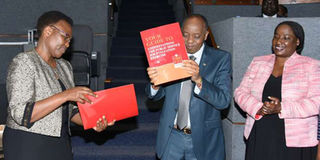SRC releases new job structure for public servants

Sarah Serem (left), the chairperson of the Salaries and Remuneration Commission, and Joseph Kinyua (centre), the Chief of Staff and Head of Public Service, release results of job evaluation for the public service at Kenyatta International Convention Centre in Nairobi on November 11, 2016. PHOTO
What you need to know:
Speaking at the function which was attended by Chief of Staff and head of Public Service Joseph Kinyua, SRC chairperson Sarah Serem assured that the exercise will not result in pay cuts or job losses.
It also seeks to peg salaries to performance while harmonising the salaries of personnel across the public service.
Junior civil servants are set to earn more as the Salaries and Remuneration Commission (SRC) moves to bridge the huge wage disparities in the public service.
On Friday, the SRC released a new job structure for the country’s over 600,000 public servants which seeks to, among other things, bridge the gap between the highest and lowest pay earners.
Speaking at the function which was attended by Chief of Staff and head of Public Service Joseph Kinyua, SRC chairperson Sarah Serem assured that the exercise will not result in pay cuts or job losses.
“The new structure enhances value for low cadre jobs while maintaining value for top tier jobs,” she stated.
It also seeks to peg salaries to performance while harmonising the salaries of personnel across the public service.
It means that public servants possessing the same skills, qualifications and experience will be clustered in the same job group regardless of whether they are employees of the national government, county governments, constitutional commissions, state corporations or independent commissions.
Currently, there are huge disparities in the remuneration of public servants, with employees in some state corporations, county governments and independent and constitutional commissions earning more than their counterparts in the civil service despite possessing the same skills and qualifications.
“We want to promote equal pay for work of equal value,” said SRC Chief Executive Officer Ann Gitau.
She added that the job evaluation had covered 36,000 state officers and that stakeholders had been involved throughout the 17-month exercise.
Under the new structure, senior public servants including Secretaries, Ambassadors, Commissioners, Deputy Commissioners, Chief Officers, Directors, senior deputy directors, Principals, CEOs and deputy CEOs of constitutional independent commissions will fall in job group E.
IN CORPORATIONS
Also falling in Job Group E will be CEOs, executive directors, managing directors, directors general, managing trustees, general managers, commission secretaries and commissioners general in state corporations.
In county governments, the chairpersons of the County Public Service Boards will also fall under Job Group E.
Senior and middle level managers as well as high level specialists including section heads and heads of departments in the civil service will fall in Job Group D under the new structure.
Also to fall in this job group are senior managers and assistant directors in constitutional and independent commissions. In state corporations, those to be clustered in job group D will include general managers in charge of human resource, supply chain, corporate services and medical specialists among other senior and middle level specialists.
Job group C will mainly comprise supervisors and highly skilled officers while job group B will comprise skilled and low level supervisory staff.
The lowest job group – A – will comprise very low skilled basic workers such as cooks, clerks, security guards, messengers, copy readers, drivers, telephone operators and receptionists.
The SRC chairperson stated that teachers will not be affected by the new structure as their remuneration had already been addressed in the Collective Bargaining Agreement their unions signed with the government recently.
She expressed optimism that the new CBA between teachers’ unions and the government will bring to an end the constant teachers’ strikes which had impacted negatively on the education sector in the country over the years.
EFFECTIVE JULY
Ms Serem also explained that the new salary structure will become effective in July next year when the new financial years starts.
She lamented that despite the public service being the employer of choice currently, productivity still stood at a low 30 per cent hence the need to review the pay structure to reward productivity and punish non-performance.
Mr Kinyua on his part noted that the new salary structure will go a long way in ensuring equity and fairness in the remuneration of public servants.
“It is a well-known fact that for a very long time, public service officers were not clear on the real worth of their jobs and often negotiation for salaries was based on whims and not research. This gave room for unstructured and ad hoc determination of remuneration which resulted in skewed salary structures,” he said.
He added that this disparity had affected the morale and capacity of public officers to perform their duties and implementation of national policies.
“This exercise by the SRC and its outcome is, therefore, important. The worth of jobs will enable the Government to determine pay to each job grade and ensure there is equity and fairness in remuneration,’ he went on.
“Teachers, doctors, nurses, police, and other civil servants provide critical service to our people. They, therefore, should be fairly remunerated. But this should be based on an objective and scientific assessment that clearly spells out, as much as possible, their worth,” Mr Kinyua stated.





